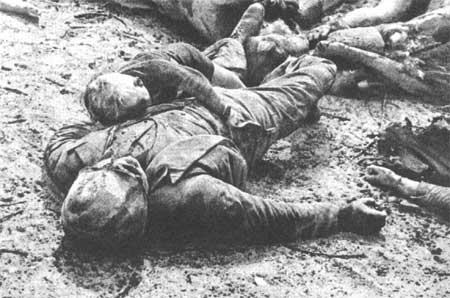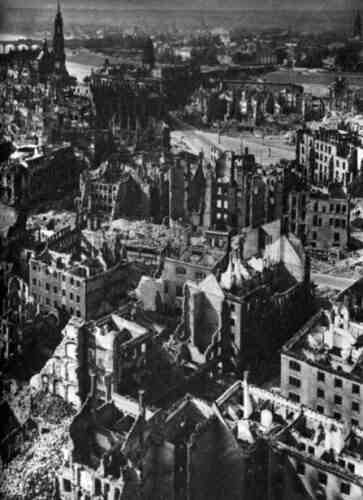Winston Churchill, memorandum to Air Marshall Arthur Harris (28th March 1945)
"It seems to me that the moment has come when the question of bombing of German cities simply for the sake of increasing the terror, should be reviewed. Otherwise we shall come into control of an utterly ruined land. We shall not, for instance, be able to get housing material out of Germany for our own needs because some temporary provision would have to be made for the Germans themselves. I feel the need for more precise concentration upon military objectives, such as oil and communications behind the immediate battle-zone, rather than on mere acts of terror and wanton destruction."
 Dresden's population had almost doubled in the months before the attack, mainly as a result of the influx of refugees from the Eastern Front, most of them women and young children. According to British historian David Irving, the briefings given to the British bomber squadrons before the attack on Dresden were curiously different. In one, the soldiers were told that their target was the railway center of Dresden. In another, they were told that the target was a poison-gas factory. In yet another, they were told that the target was a marshalling-grounds for troops in the city. Another was told that the target was a major arsenal. These were all lies.
Dresden's population had almost doubled in the months before the attack, mainly as a result of the influx of refugees from the Eastern Front, most of them women and young children. According to British historian David Irving, the briefings given to the British bomber squadrons before the attack on Dresden were curiously different. In one, the soldiers were told that their target was the railway center of Dresden. In another, they were told that the target was a poison-gas factory. In yet another, they were told that the target was a marshalling-grounds for troops in the city. Another was told that the target was a major arsenal. These were all lies.
G.C. Gifford, a Canadian navigator who flew in the raid (and later formed a veterans peace group) told Peace magazine in 1985: “The Dresden bombing was the only raid we went on where we didn’t like what we were going to do before we started. The Squadron Commander had said, ‘Well, we’ve got a juicy one tonight. It’s full of refugees.’ We knew it hadn’t been seriously bombed in the war so we knew it was not an important military target, and we knew that the Russians were only 30 kilometres on the other side of it and moving fairly fast, and the Americans were 70 kilometres on this side. So we didn’t feel good about that one.”
The carnage that resulted from what survivors described as a firestorm is chilling. Temperatures reached in excess of 1500 degrees centigrade, causing gusts of hot air to literally fling people into flames or incinerate them on the spot within seconds. Others died from asphyxiation as the oxygen was sucked from their lungs.
Margaret Freyer was living in Dresden during the firestorm created on 13th February, 1945.
The firestorm is incredible, there are calls for help and screams from somewhere but all around is one single inferno touxiang.
To my left I suddenly see a woman. I can see her to this day and shall never forget it. She carries a bundle in her arms. It is a baby. She runs, she falls, and the child flies in an arc into the fire.
Suddenly, I saw people again, right in front of me. They scream and gesticulate with their hands, and then - to my utter horror and amazement - I see how one after the other they simply seem to let themselves drop to the ground. (Today I know that these unfortunate people were the victims of lack of oxygen). They fainted and then burnt to cinders. Insane fear grips me and from then on I repeat one simple sentence to myself continuously:
"I don't want to burn to death". I do not know how many people I fell over. I know only one thing: that I must not burn.
Those who survived the ferocious night attack by British bombers had to endure the second raid by US bombers on the morning of February 14. The raids flattened around 15 square kilometres of the city. Fires burned across Dresden for seven days (the smoke could be seen as far away as London) and the city continued to smoulder for weeks.
Most estimates put the death toll at around 35,000, but some claim it was three or four times this figure.
No matter what side one comes down on in the debate over the bombing of Dresden. One should remember this quote in the nineteenth century by Friedrich Wilhelm Nietzsche.
"Whoever fights monsters should see to it that in the process he does not become a monster. And when you look into an abyss, the abyss also looks into you."



 These women and children, these wounded soldiers, these infirm and elderly people, these refugees fleeing from the brutal onslaught of the Communist armies to the East, had come to Dresden because it was commonly believed at the time that Dresden would not be attacked. Its lack of strategic or military or industrial significance, and the well-known presence of hundreds of thousands of innocent civilian refugees and even Allied prisoners of war, seemed to guarantee safety to the city. Surely, it was thought, not even a the most powerful and determined enemy would be so depraved and sadistic, and so wasteful of that enemy's own resources, to attack such a city. But the people of Dresden, who were happily attending the cinema or eating dinner at home or watching the show-horses in the circus on that fateful night were wrong. And their leaders were also wrong, for the city was virtually open and undefended and only minimal civil defense preparations had been made.
These women and children, these wounded soldiers, these infirm and elderly people, these refugees fleeing from the brutal onslaught of the Communist armies to the East, had come to Dresden because it was commonly believed at the time that Dresden would not be attacked. Its lack of strategic or military or industrial significance, and the well-known presence of hundreds of thousands of innocent civilian refugees and even Allied prisoners of war, seemed to guarantee safety to the city. Surely, it was thought, not even a the most powerful and determined enemy would be so depraved and sadistic, and so wasteful of that enemy's own resources, to attack such a city. But the people of Dresden, who were happily attending the cinema or eating dinner at home or watching the show-horses in the circus on that fateful night were wrong. And their leaders were also wrong, for the city was virtually open and undefended and only minimal civil defense preparations had been made.
 Dresden's population had almost doubled in the months before the attack, mainly as a result of the influx of refugees from the Eastern Front, most of them women and young children. According to British historian David Irving, the briefings given to the British bomber squadrons before the attack on Dresden were curiously different. In one, the soldiers were told that their target was the railway center of Dresden. In another, they were told that the target was a poison-gas factory. In yet another, they were told that the target was a marshalling-grounds for troops in the city. Another was told that the target was a major arsenal. These were all lies.
Dresden's population had almost doubled in the months before the attack, mainly as a result of the influx of refugees from the Eastern Front, most of them women and young children. According to British historian David Irving, the briefings given to the British bomber squadrons before the attack on Dresden were curiously different. In one, the soldiers were told that their target was the railway center of Dresden. In another, they were told that the target was a poison-gas factory. In yet another, they were told that the target was a marshalling-grounds for troops in the city. Another was told that the target was a major arsenal. These were all lies.